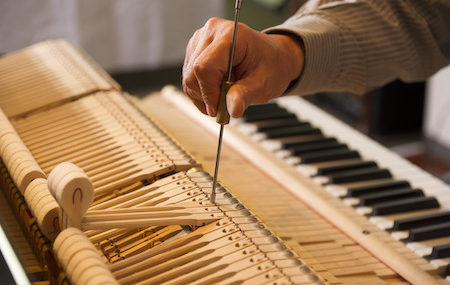Looking for a piano? A quick search online will lead you in many directions. Should you buy new? Should you look for “deals” on Craigslist? Or should you restore the old piano you found in your grandmother’s basement?
It may surprise you that restoring old pianos might be the way to go.
Nothing beats the beauty and sound of a well-made piano. For some players, a piano is more than an instrument; it’s a part of their life.
If you’ve found the “perfect” instrument, and it happens to be an antique from decades ago, don’t fret. There is an art to restoring old pianos and ensuring they sound even better than some new ones. Restoration requires skill, craftsmanship, and attention to detail. It might just lead you to the “perfect” piano to suit your needs.
Where do you start?
Not every piano is worth restoring. But how do you know? The first step is to assess a piano’s condition. A professional piano restoration technician will carefully examine the instrument, looking for any signs of wear and tear, such as cracks in the soundboard, worn hammers, or broken strings. They’ll also check if it’s in tune and listen to the sound quality. Once they’ve assessed the piano’s condition, they can provide a better estimate of what it will take to restore it.
Look good inside and out
Sound quality might be the most important item to restore on an old piano, yet many start with how it looks. If the piano’s veneer is damaged or has lost its luster, it’s time to refinish it. Refinishing involves removing the old finish, lightly sanding the wood, and applying a new finish. A professional will always match the original finish as closely as possible, ensuring that the piano’s aesthetic value is restored.
Let’s talk parts
Sometimes, piano parts can become damaged beyond repair. Strings can break, hammers can wear down, or the pedals can weaken. Replacing these parts can be time-consuming, but it’s necessary to restore the piano’s looks, sound, and feel. A skilled piano technician can replace these parts with high-quality materials, restoring the piano to its original quality.
How does it sound?
Regulation and tuning are also essential parts of piano restoration. A technician will regulate the action, adjusting the internal mechanism that connects the keys to the hammers. This ensures the keys have the proper amount of resistance and provide the correct level of expression.
From there, they’ll adjust the tension of the piano strings, ensuring that the piano is in tune and sounds great. Voicing is the process of adjusting the tone of the piano to ensure it sounds its best. It involves making adjustments to the hammers and strings to change the volume and tone of each note. This process requires the ear of a skilled technician to make sure that each note sounds exactly as it should.
Is it worth restoring old pianos?
Yes! Whether an old piano has sentimental value, or you’re looking to bring back life in a piano you’ve had for years, restoration may be the way to go.
Restoring an old piano takes patience, skill, and craftsmanship. It’s not a job for amateurs or DIYers, as piano restoration requires years of training and experience to do it justice. That said, there’s nothing quite like bringing an old piano back to life and hearing it sing again.
If you’re a piano player with an old piano that needs a little love, don’t hesitate to seek out a professional piano restoration technician and let them restore your piano to its former glory. You’ll be amazed at the difference it can make.


